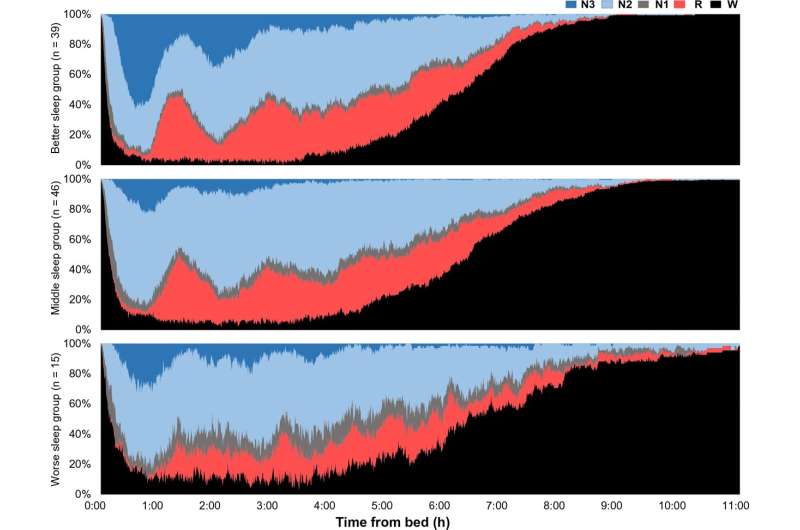Cumulative displays of sleep architecture by electroencephalogram-based sleep cluster. The X-axis indicates the time from bed, whereas the Y-axis indicates the percentage of people in each sleep stage: awake ("W"), N1, N2, N3, and REM ("R"). Credit: Scientific Reports (2023). DOI: 10.1038/s41598-023-47979-9
Researchers conducted a comprehensive study involving 100 adults aged 30–59 years by employing electroencephalogram (EEG) measurements to assess sleep quality for five nights at the participants' homes. Additionally, detailed health examinations were conducted at a health care facility in Tokyo. The objective was to explore the relationship between sleep quality and various physical health parameters. Notably, individuals with poor objective sleep quality exhibited a tendency toward unfavorable physical health indicators, particularly elevated systolic blood pressure.
Ten sleep parameters derived from the EEG data collected during the five-night home study were used to categorize participants into three groups—namely, the good sleep group (comprising 39 participants), the intermediate group (comprising 46 participants), and the poor sleep group (comprising 15 participants), utilizing the k-means++ clustering method, a form of unsupervised machine learning within the domain of artificial intelligence (AI). Then, the researchers evaluated 50 physical health parameters across these groups.
Statistically significant differences were observed in systolic and diastolic blood pressure, γ-GTP (a marker of liver function), and serum creatinine (a marker of kidney function). Of these, the differences in systolic blood pressure were particularly pronounced, consistently higher among participants of the poor sleep group.
Furthermore, the study unveiled a weak correlation between objective sleep quality, as measured by EEG during sleep, and subjective sleep quality as assessed using the Athens Insomnia Scale. Notably, only objective sleep quality exhibited an association with systolic blood pressure. Additionally, the research identified specific combinations that displayed relatively strong correlations between the 10 EEG-derived sleep metrics and the 50 physical health parameters.
This study highlights the utility of home-based electroencephalography for the objective assessment of sleep quality, offering valuable applications in clinical practice and research endeavors.
More information: Masao Iwagami et al, Association between electroencephalogram-based sleep characteristics and physical health in the general adult population, Scientific Reports (2023). DOI: 10.1038/s41598-023-47979-9
Journal information: Scientific Reports
Provided by University of Tsukuba
























